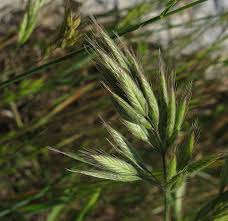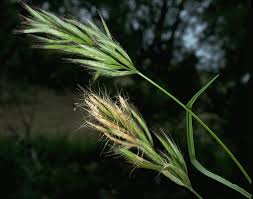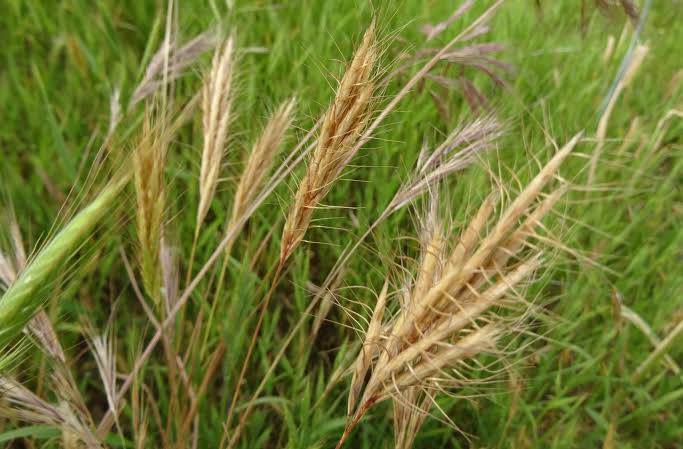Weedy brome, scientifically known as Bromus alopecuros, is a type of plant that can cause challenges in various environments. This plant is often considered a weed due to its ability to grow quickly and compete with other plants for resources. Its impact on crops and natural habitats has made it a subject of concern among farmers and conservationists alike.
Weedy brome is an annual grass that typically grows between 30 to 100 centimeters tall. It has slender stems and long, narrow leaves that give it a distinctive appearance. One of the key characteristics of this plant is its inflorescence, which forms a loose, open seed head containing numerous tiny flowers. These flowers can produce a significant number of seeds, contributing to the plant’s ability to spread and establish itself in new areas.
This species is adaptable and can thrive in a variety of habitats, including agricultural fields, roadsides, and disturbed areas. Its ability to germinate and grow rapidly allows it to outcompete desirable plants, leading to reduced crop yields and changes in ecosystem dynamics. Farmers often face challenges in managing weedy brome, as it can negatively impact the quality and quantity of their harvests.
In addition to its ecological impact, weedy brome has been known to interfere with natural vegetation in grasslands and other ecosystems. The displacement of native plants by this invasive species can have cascading effects on local wildlife, disrupting food webs and altering the overall biodiversity of an area.
Efforts to control weedy brome involve a combination of cultural, mechanical, and chemical methods. Crop rotation, proper land management practices, and the use of herbicides are among the strategies employed to mitigate its impact. However, managing this weed requires a holistic approach, as its ability to adapt to different conditions makes it a persistent challenge for land managers and farmers alike.
Additionally, Weedy brome, scientifically identified as Bromus alopecuros, poses a significant challenge in various environments due to its rapid growth and competitive nature. This annual grass can impact agricultural productivity and disrupt natural ecosystems, prompting the need for effective control measures.
The ongoing efforts to manage weedy brome underscore the importance of understanding and addressing the ecological implications of invasive plant species for the health of our ecosystems and agricultural landscapes.
Read Also: The History and Origin of Burmese Pythons
How To Grow Weedy Brome (Bromus alopecuros)

Growing weedy brome (Bromus alopecuros) intentionally is not a common practice, as it is considered a weed due to its invasive nature and potential negative impact on other plants and ecosystems. However, if you’re conducting research or need to manage it for specific purposes, here are general guidelines:
1. Seed Selection: If you intend to grow weedy brome for research purposes, obtain seeds from a reputable source. Be cautious and ensure compliance with local regulations regarding the cultivation of potentially invasive species.
2. Site Selection: Choose a controlled and confined area for cultivation to prevent the unintentional spread of weedy brome to natural habitats. Ensure that the site has well-drained soil and receives adequate sunlight.
3. Sowing Seeds: Sow weedy brome seeds in the designated area during the appropriate planting season for your region.
Follow recommended seeding rates, considering the potential for prolific seed production by this species.
4. Watering: Provide regular watering to support germination and initial growth. Weedy brome is known to adapt well to different moisture conditions.
5. Monitoring and Maintenance: Regularly monitor the growth of weedy brome plants. Be aware of its tendency to outcompete other plants, and manage accordingly. Consider implementing measures to prevent the unintentional spread of seeds to surrounding areas.
6. Harvesting (Optional): If your goal is to harvest seeds for research purposes, allow the plants to mature and produce seeds. Harvest them when they are fully developed but before they naturally disperse.
7. Containment and Preventing Spread: Take precautions to prevent the spread of weedy brome beyond the cultivation site. This may include cleaning equipment thoroughly and disposing of plant material responsibly.
8. Disposal: Dispose of any remaining plant material properly to avoid accidental spread. This is crucial to prevent weedy brome from becoming a nuisance in unintended locations.
9. Research Compliance: If you are growing weedy brome for research, ensure compliance with ethical and regulatory guidelines. Obtain any necessary permits and approvals before initiating cultivation.
Remember, growing weedy brome should be approached with caution and responsibility, considering its potential impact on the environment. Always adhere to local regulations and guidelines to prevent unintended consequences.
How To Care For Weedy Brome (Bromus alopecuros)
Caring for weedy brome (Bromus alopecuros) can be a challenge, as it is generally considered a weed due to its invasive nature. However, if you find it necessary to manage or control its growth, here are some guidelines:
1. Identification: Learn to identify weedy brome accurately. This will help you differentiate it from desirable plants and allow for targeted management.
2. Cultural Practices: Implement practices that discourage the growth of weedy brome. This may include proper crop rotation, as well as maintaining healthy and competitive stands of desirable plants.
3. Mechanical Control: Use mechanical methods such as mowing or cutting to reduce the height of weedy brome. This can prevent seed production and limit its spread.
4. Early Detection: Monitor your landscape regularly for signs of weedy brome. Early detection allows for more effective control measures before it becomes widespread.
5. Herbicide Application: If necessary, consider the use of herbicides specifically designed to control weedy brome. Follow recommended application rates and guidelines, and be aware of any potential impacts on non-target plants.
6. Prevent Seed Spread: Be cautious not to spread weedy brome seeds unintentionally. Clean equipment, clothing, and footwear to avoid transporting seeds to new locations.
7. Integrated Pest Management (IPM): Implement an integrated approach to managing weedy brome, combining cultural, mechanical, and chemical methods. This holistic strategy is often more effective than relying on a single control method.
8. Environmental Considerations: Be mindful of the surrounding environment when applying control measures. Consider the potential impact on non-target plants, wildlife, and water sources.
9. Follow Local Regulations: Adhere to local regulations regarding the management of invasive species. Some areas may have specific guidelines or restrictions on the control methods that can be employed.
10. Regular Monitoring: Continuously monitor the effectiveness of your control measures. Adjust your strategy as needed to address changes in weedy brome populations.
11. Consult Experts: If you are unsure about the best approach to manage weedy brome in a specific context, consult with local agricultural extension services or weed management experts for advice.
Remember that the goal is typically to control or minimize the impact of weedy brome rather than promote its growth. It’s crucial to consider the potential consequences of its presence on the local ecosystem and take measures accordingly.
Rwad Also: The Top Global Trends Driving the Fourth Agricultural Revolution
The Uses of Weedy Brome (Bromus alopecuros)

Weedy brome (Bromus alopecuros) is generally considered a weed due to its invasive nature and potential negative impact on crops and natural ecosystems. As such, it is not commonly cultivated for specific uses. However, some aspects of its biology and ecology may have indirect implications:
1. Wildlife Habitat: Weedy brome can contribute to wildlife habitat by providing cover and food for certain animal species. However, its invasive nature may also disrupt native plant communities, affecting the overall biodiversity of an area.
2. Research and Study: Researchers may study weedy brome to better understand its biology, ecology, and methods of control. This information can be valuable for developing strategies to manage invasive species and mitigate their impact on ecosystems.
3. Educational Purposes: Weedy brome may be used in educational settings to demonstrate the challenges associated with invasive plants. This can help students and researchers learn about the importance of maintaining balanced ecosystems and the consequences of invasive species.
4. Erosion Control (Limited): In certain situations, weedy brome may be used for erosion control on disturbed sites. Its ability to establish quickly and cover the ground could be exploited for stabilizing soil in specific contexts.
It’s important to note that while some aspects of weedy brome’s biology may have potential uses, the overall impact of this species is often negative. In agricultural settings, efforts are typically focused on controlling and managing weedy brome to minimize its effects on crop yields. Always consider local regulations and environmental implications when dealing with invasive species.
Frequently Asked Questions (FAQs)
Q: What is Weedy brome (Bromus alopecuros)?
A: Weedy brome, scientifically known as Bromus alopecuros, is an annual grass that is often considered a weed due to its invasive nature. It can grow rapidly and outcompete other plants, impacting agricultural crops and natural ecosystems.
Q: Why is Weedy brome a concern?
A: Weedy brome is a concern because of its ability to disrupt ecosystems and reduce crop yields. Its aggressive growth and prolific seed production make it challenging to manage, and it can negatively impact biodiversity in affected areas.
Q: How can I identify Weedy brome?
A: Weedy brome typically has slender stems, long narrow leaves, and an open seed head with tiny flowers. Proper identification is crucial for effective management, as it helps distinguish it from desirable plants.
Q: What environments does Weedy brome thrive in?
A: Weedy brome is adaptable and can thrive in various environments, including agricultural fields, roadsides, and disturbed areas. It can establish itself in both cultivated and natural landscapes.
Q: How can I control Weedy brome in my garden or field?
A: Control methods for weedy brome include cultural practices like crop rotation, mechanical methods such as mowing, and, if necessary, the use of herbicides. Integrated pest management (IPM) approaches that combine multiple strategies are often effective.
Q: Can Weedy brome be used for any beneficial purposes?
A: Weedy brome is not commonly cultivated for specific uses due to its invasive nature. However, it may indirectly contribute to wildlife habitat and could be studied for research and educational purposes to better understand invasive plant management.
Q: Is Weedy brome harmful to animals or humans?
A: While weedy brome itself is not typically harmful to animals or humans, its impact on ecosystems and agriculture can indirectly affect wildlife and human activities. The displacement of native plants and competition for resources can have cascading effects.
Q: How can I prevent the spread of Weedy brome to new areas?
A: Preventing the spread of weedy brome involves cleaning equipment, clothing, and footwear to avoid transporting seeds. Early detection and management efforts can also help limit its establishment in new locations.
Q: Are there regulations regarding the cultivation or control of Weedy brome?
A: Local regulations may vary, but it’s important to be aware of any guidelines or restrictions related to the cultivation and control of invasive species like weedy brome. Consult with local agricultural extension services or authorities for specific information.
Read Also: Water and Waste-water Purification Process

